#South American Fauna
Explore tagged Tumblr posts
Text

"Try me" (2023-4)
Last OC painting of last year, and first into this one ^^ I have this small tradition, of making one last of them as a year closes.
This one was a coloring of a doodle I'd had laying around for literally months, and I ended up quite happy with it.
I've been quite busy, I hope you're all doing well!
#Puma#Cougar#Felines#Awkacomic#Eduardo#Whiskers#HighMountain#OC paintings#2023#2024#Nothofagus-obliqua#animals#South American Fauna
13 notes
·
View notes
Text
Patagonia Region in Argentina and Chile...









#nature#hiking#travel#naturecore#nature photography#patagonia#argentina#chile#glacier#wildlife#wildflowers#mountains#andes mountains#cougar#puma#south america#south american wildlife#landscapes#trees#forests#lakes#mountainside#snow capped mountains#guanaco#vicuña#flora and fauna
22 notes
·
View notes
Text

Fast Fauna Facts #11 - Scarlet Macaw (Ara macao)
Family: Macaw Family (Psittacidae)
IUCN Conservation Status: Least Concern
Like other macaws the Scarlet Macaw's bill is large, powerful and unusually flexible, allowing it to manipulate and break hard fruits and seeds when feeding. Scarlet Macaws have frequently been observed using this ability to feed on hard unripe fruit, and as most other fruit-eating animals in their range are unable, or unwilling, to feed on such fruits it has been suggested that this is an adaptation that allows them to access food sources their competitors cannot. Many unripe fruits contain chemicals called tannins which are bitter-tasting and weakly acidic in order to discourage animals from eating them until the seeds within them are mature and ready to be spread, and the acidity of the tannins they eat may explain why Scarlet Macaws have occasionally been observed engaging in geophagy (the act of swallowing soil, rocks or, in the case of Scarlet Macaws, clay), as most clay is weakly alkaline and therefore may help to neutralize the tannins and make them easier to digest.
-----------------------------------
Image Source: Here
<-Previous (Rhubarb) I Next (Century Plant)->
#fast fauna facts#scarlet macaw#bird#birds#parrot#parrots#animal#animals#zoology#biology#ornithology#wildlife#south american wildlife#central american wildlife#north american wildlife
34 notes
·
View notes
Photo
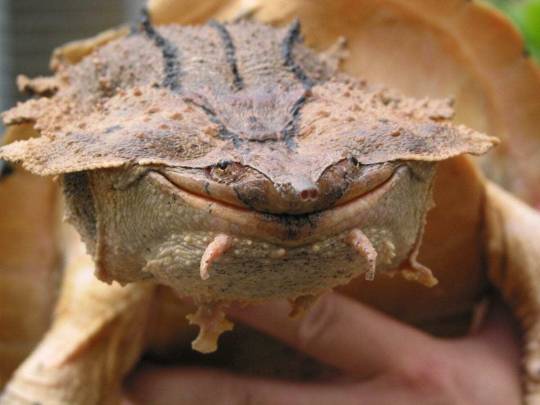
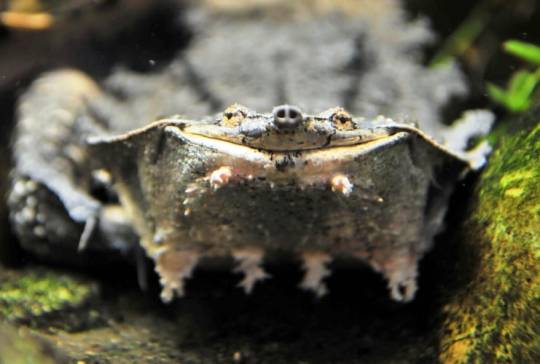
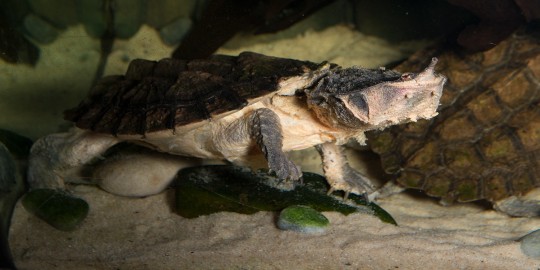
A Mata-Fine Mata Mata turtle
A resident of the Amazon and Orinoco river basins, the mata mata (Chelus fimbriatus) is a species of freshwater turtle found in streams, pools, and wetlands throughout northern South America, from Venezuela to Brazil, as well as the island of Trinidad. This species is almost entirely aquatic, and excursions on land are extremely rare. However, they are not well adapted for swimming in open water, and are thus most commonly seen in shallow bodies of water with soft, muddy bottoms.
C. fimbriatus has a unique appearance among turtle species. The carapace-- the part of the shell that covers the back--it has three ridges running down its length and is often covered in algae, and so resembles tree bark. The head is similarly shaped to resemble leaf litter; it’s triangular, and the fringes around the cheeks and mouth break up the outline. The mata mata’s nose is long and snorkel-like, allowing it to remain just under the surface. Despite its unobtrusive looks, this species is actually quite large; mata mata can grow up to 45 cm (1.5 ft) long and weigh up to 17.2 kg (38 lbs).
Because of its unique body shape and camouflage, the mata mata is well suited to a sedentary life, and has few natural predators. It has extremely poor eyesight, though it does share an adaptation with other nocturnal reptiles that allows the eyes to reflect low levels of light. To compensate, the mata mata relies on its hearing, amplified by a large tympanium on either side of the head, and on the barbels lining its jaw. In addition to being an excellent costume, these barbels allow C. fimbriatus to sense vibrations in the water. The mata mata spends most of its time submurged or buried under the mud, waiting for potential prey like fish, worms, crustaceans, and insects to swim by. When they’re close enough, the mata mata opens its jaws and sucks its target in whole. Individuals have also been recorded herding schools of fish into confined areas before feeding.
The only time the mata mata emerges from the water is to reproduce. Individuals are solitary until September or October, when they begin to seek out mates. When a male encounters a female, he approaches while opening and closing his mouth, extending his limbs, and moving the flaps on the side of his head. If the female is impressed, she allows him to mount. Afterwards, she hauls herself out onto the nearby bank and builds a rudimentary nest from the forest litter. There, she lays 12-28 eggs, which will take about 200 days to hatch. There is no information on how long hatchlings take to fully mature, but individuals can live anywhere from 15-30 years.
Conservation status: The mata mata has not been evaluated by the IUCN, but is threatened by habitat destruction and overharvesting for the pet trade.
If you like what I do, consider leaving a tip or buying me a ko-fi!
Photos
Rune Midtgaard
Christopher Wellner
Joachim S. Muller
#mata mata#Testudines#Chelidae#Austro-South American side-neck turtles#side-neck turtles#turtles#reptiles#freshwater fauna#freshwater reptiles#rivers#river reptiles#wetlands#wetland reptiles#south america#Northern South America#Amazon Rainforest#animal facts#biology#zoology
240 notes
·
View notes
Text


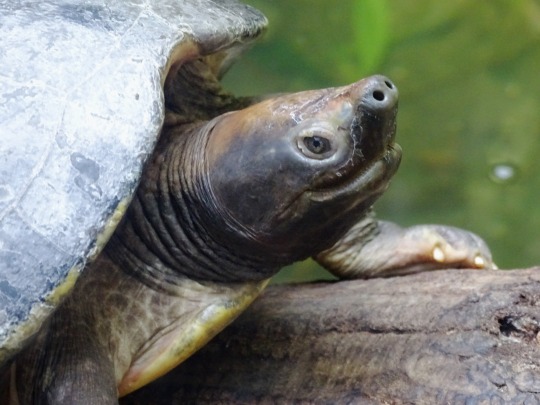
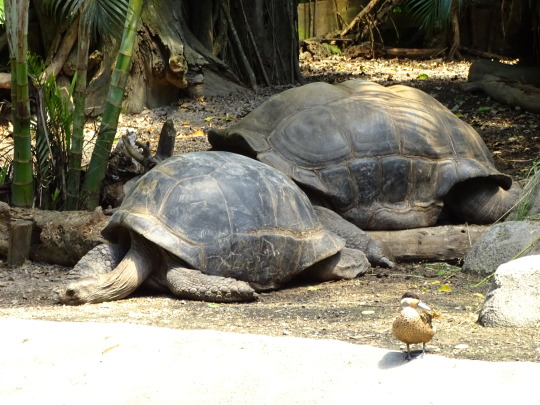
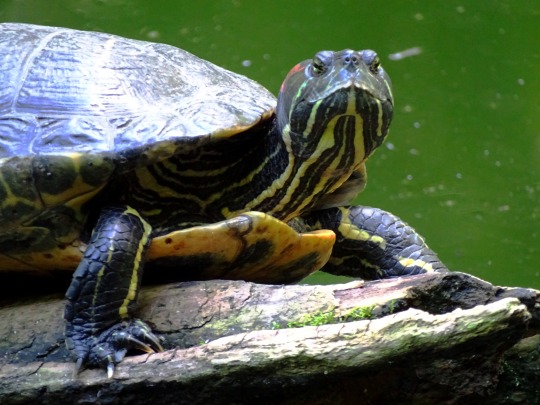
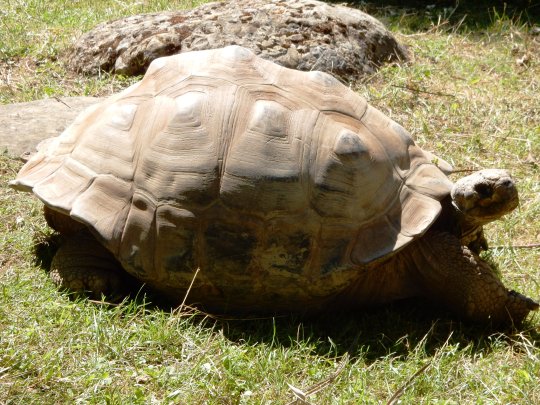
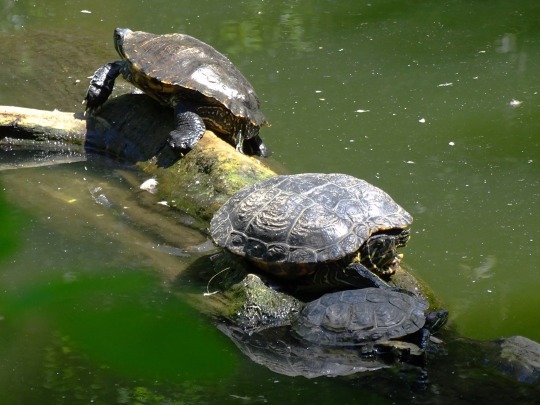
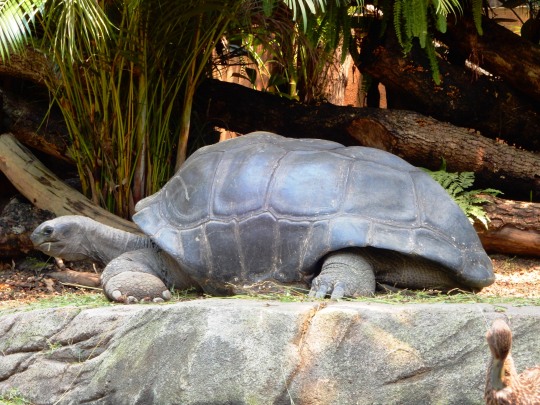
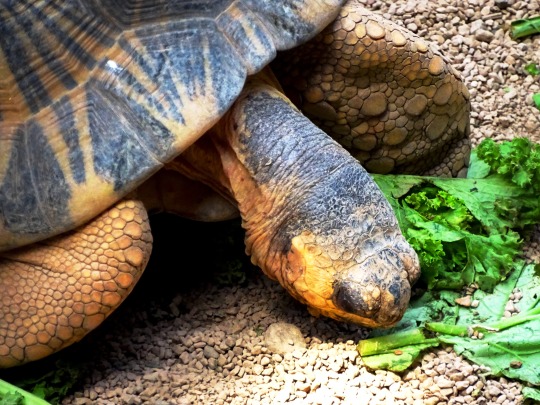
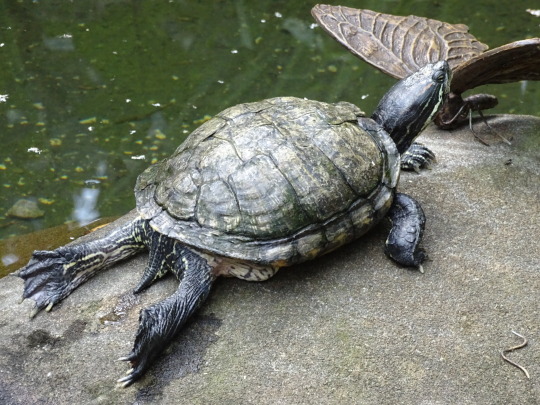
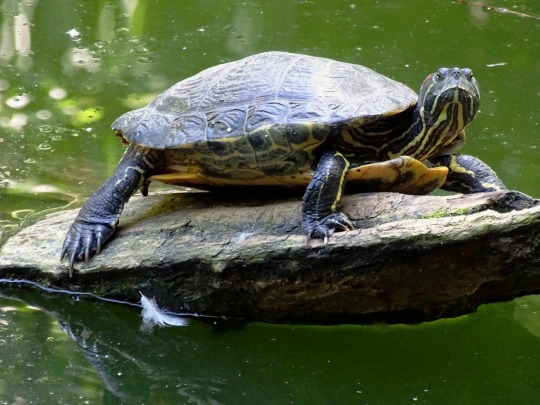
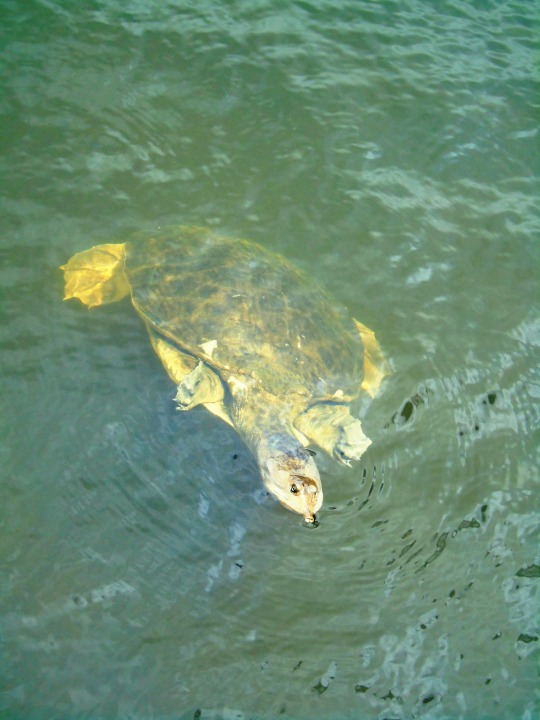
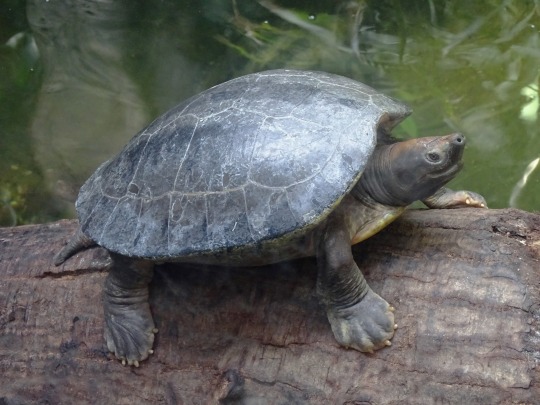
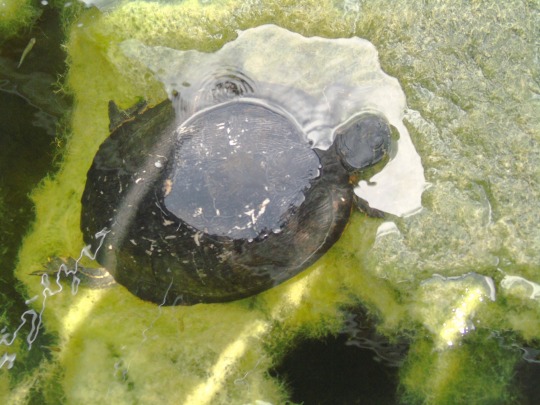
World Turtle Day
World Turtle Day is celebrated on May 23 of every year. The World Turtle Day promoted yearly since 2000 by American Tortoise Rescue which is to bring attention to increase knowledge of and respect for, turtles and tortoises, that inspire human action to help them survive and succeed.World Turtle Day is celebrated around the spheroid in a variation of ways, from dressing up as turtles also by wearing green summer dresses to saving turtles caught on roadways, to research projects. Turtle Day lesson plans and craft designs promote teaching about turtles in classrooms. World Turtle Day is also to celebrate the great reptiles with their place in the world, and this encourages people to take action to protect them, both the common pet turtle and the ever jeopardized sea turtle.
“World Turtle Day is an annual opportunity to reflect on the myriad of threats facing turtles and tortoises and what we can do to protect them.”
History of World Turtle Day
World Turtle Day was created by American Tortoise Rescue in 1990. The term “WORLD TURTLE DAY” is branded by Susan Tellem of Malibu, California American Tortoise Rescue is certified by state and federal companies as a nonprofit corporation to provide for the protection of all species of tortoise and turtle. Orphans that cannot affirm because of ill health remain in the care of American Tortoise Rescue for the balance of their lives. Chase’s Book of Annual Events, the day was created as an annual observance to help people to protect turtles and tortoises and to disappear their habitats globally. Susan Tellem and Marshall Thompson are the founders of the rescue American Tortoise Rescue defend the humane treatment of all animals, containing reptiles. Since 1990, ATR has placed about 3,000 tortoises and turtles in caring homes and also assist law enforcement when undersize and compromised turtles are impounded and provides helpful information which has referrals to persons with sick and abandoned turtles.
In 2013, For over 5,500 students, 160 free Turtle Day Lesson planned and teaching materials were sent out to classrooms. Lesson plans were provided by the Turtle and Tortoise Preservation Group, an organization that is open to all people interested in the welfare of chelonians.
How to Celebrate World Turtle Day
Celebrate the World Turtle Day around the spheroid in a contrast of ways, from dressing up as turtles by wearing green summer dresses to rescuing turtles caught on roadways, to research projects. They’re the astonishing creature, with positive grades making great pets and helping to preserve the eco-system in the waters they live in. Also if we live where snapping turtles haunt the waters, it’s probably a good idea that people know how to withdraw them and where to find them.
Source
#Red-eared Slider#World Turtle Day#WorldTurtleDay#Shellebrate#23 May#Bronx Zoo#Zoo Zürich#Zurich#Schweiz#Switzerland#flora#fauna#water#original photography#Aldabra giant tortoise#Radiated tortoise#USA#Giant South American River Turtle#Galápagos tortoise#everything is Due South#Spider tortoise#reptile#New York City#animal#reflection#travel#vacation#tourist attraction#I really love the first pic#wildlife
3 notes
·
View notes
Text
I love how I created a world whose arrangement of continents could have totally allowed for a Centauri-Xon situation but opted to only give the world a single sentient (suspiciously human-looking) species
My loss, I suppose
Though I doubt that continent's animal and plant inhabitants managed to escape tragedy...
#brain vomit#centauri#xon#basically imagine a near supercontinent straddling most of the northern hemisphere#this world's Christopher Columbus would have easily discovered the shortcut to the other side of the continent#meanwhile located entirely in the southern hemisphere's temperate zone is a South American sized continent#possibly going undiscovered until after sailors had gotten longitude worked out#its flora and fauna could be radically different from the mainlands#but how much of it survived the introduction of foreign plants and animals I wonder#I also wonder what might have been brought back that could've caused trouble on the mainlands#what might this planet's version of mint and rats be
0 notes
Text
History yelling time, because I am a very excitable little bean. I know I probably wailywailed about this at the time, but I need to waily wail some more.

We get a very, very brief glimpse of this map, followed by Zheng's fleet coming through the jungle and the tiny moment of that had me yelling and flailing because it's a hugely significant historical place that she's bringing them across.
This is the Darien Gap, one of the narrowest points between the north and south American continents. This is a map from 1732, where you can still see a spot marked "New Caledonia" (ie. New Scotland).
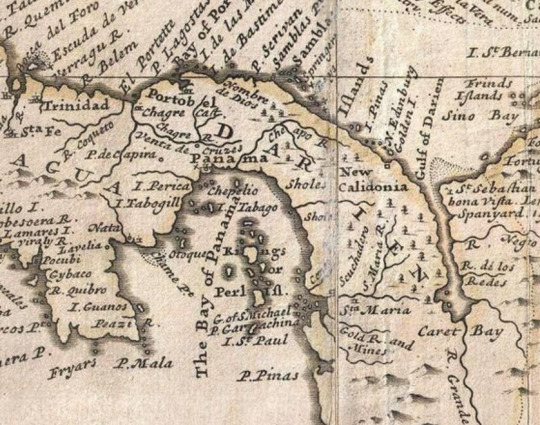
In the late 17th/early 18th century, Scotland tried to set up a crossing from the Atlantic to the Pacific in order to make a fortune in trade by cutting out the need to go around South America and/or Africa. It did not end... well. That is an understatement.
The fact that Zheng is specifically bringing them across at the point where the New Caledonia settlement was based tickles me so much. She's succeeded in doing the crossing and she's done it with a large number of her ships so discreetly that no one has noticed. She's someone who has plans and contingencies and Gets The Work Done.
She also has a varied and diverse crew who would bring different experiences and knowledge to the table unlike the herd of very beige Scotsmen who got to Darien and couldn't deal with the climate, the bugs, the altitude, the flora, the fauna and... well... everything.
And while some people wondered what that scene was kept in for since her ships were blown up - only her ships that were already in the Caribbean were blown up. As you can see on that first map, she has a whole queue lined up to come over. It's all optimistic set-up for S3: her second fleet is coming and Ricky is gonna rue the day he pissed her off.
And for the curious, a connection was eventually made in/around that specific area, but not until the late 19th century and it was only completed in 1904.

112 notes
·
View notes
Text
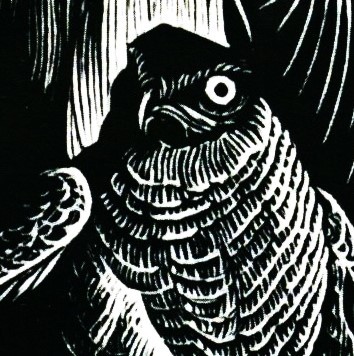


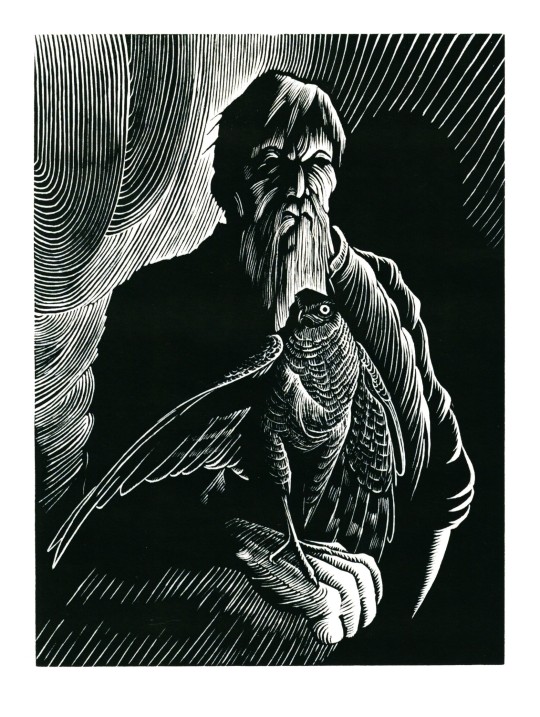
Another Wood-engraved Feathursday
JOHN MCWILLIAMS
Now here's a couple of intense fellows! The print is entitled Sparrow Hawk by South Carolina artist and engraver John McWilliams (b. 1941). The print was selected for inclusion in the Fourth Triennial Exhibition 2020-2022 of the American wood engravers society, the Wood Engravers’ Network (WEN), and this image is from the catalog for that traveling show.
McWilliams's work is inspired by Lowlands flora and fauna, so it seems a little odd that he would choose as his subject the Eurasian Sparrow Hawk (Accipiter nisus) rather than the American Kestrel (Falco sparverius), which is so common to his native habitat. Both species are used in falconry. Nevertheless, both offer something for the engraver, and we enjoy how McWilliams's Sparrow Hawk looks like it's about to take a bow.
John McWilliams received his BFA and MFA from the Rhode Island School of Design and is Professor/Director Emeritus of Georgia State University Ernest G. Welch School of Art and Design. He has received numerous awards, including the Guggenheim Foundation Fellowship and the National Endowment for the Arts Fellowship in photography. Today he maintains a studio in McClellanville, S.C. He counts as his inspirations the work of Albrecht Dürer and the German expressionists, the illustrations of Rockwell Kent, and the graphic novels of Lynd Ward and Frans Masereel. Of working in wood, he writes:
Woodcuts and wood engravings . . . have held much fascination for me. . . . The process of developing an image into a woodcut or wood engraving gives structure to my life. . . . It is such sweet irony that, although the act of creating gives my life structure, it nevertheless produces an enigma, a puzzle that others may interpret through their own lives. There are no easy answers. Such is life.
View more Feathursday posts.
View other posts with engravings from the WEN Fourth Triennial Exhibition.
View more engravings by members of the Wood Engraver’s Network.
View more posts with wood engravings!
#Feathursday#wood engravings#wood engravers#John McWilliams#Eurasian Sparrow Hawk#George Dirolf#Wood Engravers' Network#WEN#WEN Fourth Triennial Exhibition#exhibitions#exhibition catalogs#birds#birbs!
54 notes
·
View notes
Text
Enchanted South Tarot Deck
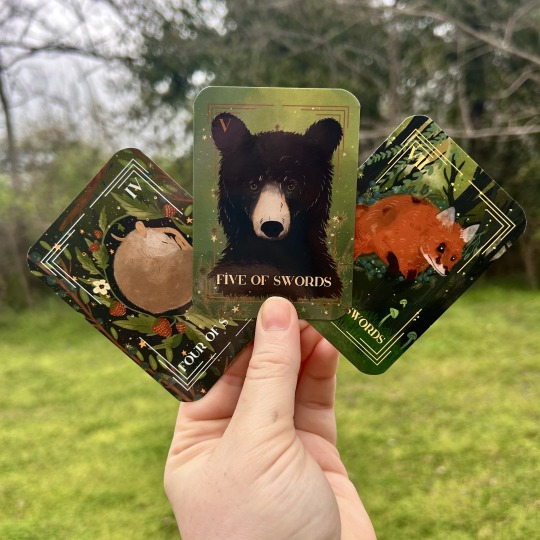


The Enchanted South Tarot deck is inspired by the rich history and symbolism of tarot and imbedded with imagery derived from the folklore, fauna, flora, and objects of the Southeast United States. Utilizing the enduring archetypes of historical decks such as the Rider-Waite-Smith, this deck features 78 original drawings depicting the lush colors, diverse plants and animals, and meaningful objects associated with the region. Traditional tarot metaphors are reimagined in this deck through magnolia seeds, honeysuckle blooms, moonshine bottles, mosquito wings, and more.
The E. S. tarot deck combines traditional tarot imagery with fauna, flora, and artifacts of the American Southeast. These elements are depicted through a whimsical lens that incorporates fairytales, folklore, and magic to create illustrations that illuminate the magic of my childhood spent playing make-believe alone in the woods. The deck incorporates lush greens, mushrooms, and insects.
All decks will come with 78 cards of the Major and Minor Arcana featuring the original artwork of Hannah Mathis, a downloadable guidebook that overviews the history of tarot, common spreads, and card interpretations for the deck, and a hunter-green velvet carrying bag.
Purchase Options:
The Honeysuckle/Basic Deck: Deck, Velvet Carrying Bag, and Downloadable Guidebook
The Magnolia: Deck, Velvet Carrying Bag, and Downloadable Guidebook, and one-of-a-kind handpainted storage box ($80 value)
The Okra: Deck, Velvet Carrying Bag, and Downloadable Guidebook, one-of-a-kind handpainted storage box, and 8"x10" limited edition print ($110 value)
Imperfect Deck: Deck with slight imperfections that did not quite pass QC. Comes with downloadable guidebook.
#cottagecore art#goblincore#dark art#cottagecore#naturecore#nature#fairycore#fungi#illustration#mushrooms#whimsical#whimsigoth#whimsicore#folklore#fairies#appalachia#southern gothic#southern goth aesthetic#dark academia#witchcraft#witchblr#witchcore#witch community#witches#tarot cards#tarotblr#tarot#tarot reading#tarot deck
43 notes
·
View notes
Text
Misc Birds (Wobrafmet, Hreakgleav, Klethghrom)

Given the delightful spread of miscellaneous medieval birds @maniculum curated for us, I could not possibly narrow them down based on any measure of quality. So I used a completely arbitrary method: according to the beastiary entry, does the bird's name comes from the sound it makes?
Sibling suggested two animals to reference, and since they both happened to live in Costa Rica I decided to limit myself to Costa Rican fauna (with one exception).

My Whobrafmet has the head of a Black vulture with the eyes, body, and iridescent feathers of the Great-tailed grackle.
My reasoning's pretty simple: Black vultures are detrivores, grackles are a) all black, and b) not the bird I'm 95% sure this entry is for.
It ended up looking a bit like an evil advisor that's been slowly poisoning the king.

My Hreakgleav has the head of an oilbird, the body and legs of a Harpy eagle, and tufted tail feathers inspired by quetzals and motmots.
The oilbird does not live in Costa Rica, but it is the only cave-dwelling bird that lives in the Americas, so I decided that northern South America was close enough :) they're one of the few birds that uses echolocation! Neat!
I wanted to incorporate a bird of prey because the entry says other birds harry them; I picked the Harpy eagle because I think they're cute. I struggled a little bit with this one because it turns out if you put a nightjar-type head on an eagle, it just...looks like an owl...
I was trying to decipher 'weighed down by its plumage' and Sibling suggested giving it a quetzel-esque tail that "looks like a ball and chain." There are seven 'balls' for the seven deadly sins; the largest is sloth.

My Klethghrom has the head of the Central American eyelash-pitviper, the body of the Amagi heron, and the Great heron's breeding plumage, with little tufts also inspired by the quetzal/motmots family.
Obvs I had to draw a literal serpent's head. Sibling suggested the eyelash-pitviper. I love their little spikes :)
Technically I didn't put the 'eyes' on the tail, but I'm very charmed by Great heron mating floof and wanted to draw it.
I really like the Klethghrom entry because my local zoo used to have a bunch of [redacted] walking around loose when I was a kid, and it's true: they do have a fearful voice and an unaffected walk.
...
Whats that? How are the 'eyes' all facing you?
Good question! (・Θ・)
...
......
(◉Θ◉)
#artist: me :)#maniculum bestiaryposting#maniculum miscellaneousbirds#whobrafmet#hreakgleav#klethghrom#I really hope between everyone we got all the birds covered!#I'm really curious about some of these little guys
11 notes
·
View notes
Text

Fast Fauna Facts #14 - Firebrat (Thermobia domestica)
Family: Silverfish Family (Lepismatidae)
IUCN Conservation Status: Unassessed
Like its close relatives the silverfishes, the Firebrat (named for its attraction to warmth which often draws it towards empty fireplaces) belongs to an unusual order of anatomically "primitive" insects that never developed wings, in contrast to most wingless insects which are descended from winged ancestors. Firebrats can be found on every continent except Antarctica and generally inhabit shaded forests where they feed on leaf litter, but like silverfishes they frequently become established in warm human homes where they may reproduce rapidly (with females laying as many as 6,000 eggs throughout their lives in clutches of over 60 at a time) and emerge from sheltered areas mainly at night to feed on any digestible matter they can find - while they prefer sugary and starchy foods such as flour and cereals they may also eat organic textiles, paper, card, dried meats and the remains of other insects, with a diverse community of mutualistic bacteria housed in their digestive systems producing enzymes that allow them to digest almost anything organic.
-----------------------------------------------------------
<-Previous (Brazil Nut Tree) I Next (Oviraptor) ->
#fast fauna facts#firebrat#silverfish#silverfishes#insect#insects#arthropod#arthropods#zoology#biology#entomology#wildlife#african wildlife#asian wildlife#european wildlife#north american wildlife#oceanian wildlife#south american wildlife#synanthropes
31 notes
·
View notes
Text
Submitted via Google Form:
Since a lot of the desert is not very habitable, my world has a lot of underground buildings in the desert very high tech so that the natural land isn't very important. What do I need to consider for this?
Tex: Do you have a particular desert in mind with this question? There’s a fair amount of deserts that are inhabited already by flora and fauna, if not to a hundred percent coverage, such as the Great Basin desert, Kalahari Desert, and the deserts of Australia.
Deserts that have less flora and fauna, and are of the more popular imagination, such as the Sahara, Gobi Desert, and Syrian Desert, will have pockets of inhabitation around places like wadis, where there’s enough underground pooled water for migrational animals - including humans - to travel to and from. It’s not unusual to see water, and thus inhabitation, around mountainous regions in the desert, or by the borders of a desert where climate zones shift based upon geological features.
Humans have been living in and around the desert for a very, very long time (Wikipedia). Because of this, they’ve developed methods of surviving, and while it might not necessarily be an analogue to denser human populations like New York City that’s teeming with life and a focus of travel, a life is made.
Aridity isn’t necessarily the domain of traditional deserts, either - mountains are a good example of this, as are certain popular examples of civilizations in these areas. Petra is a popular example, home to the Nabataeans and geographically within modern-day Jordan. A notable mountain peak, Tian Shan, in Central Asia, was one of many places the Yuezhi people lived, who were nomadic and lived not only in the surrounding area but also across places like the Tarim Basin and the Tibetan Plateau. There’s a lot of examples of similar situations in other parts of the globe, so this is not an isolated event in human history.
Now, what is your definition of high tech? Skyscrapers? Internet? Something else? Lighting is something humans have had for a while, in the form of candles, hearths, and lamps, and we’ve more or less had an electrical grid in some places since the late 1880s (Wikipedia).
Plumbing has existed for thousands of years in some form for both fresh and wastewater (Wikipedia 1, Wikipedia 2), as has architectural features such as bridges (Wikipedia) and other types of architectural works (Wikipedia). Multi-story buildings have also existed for a while, notable in Roman insulae and Egyptian city of Fustat.
Telecommunications has existed in some form for about as long as human civilization has existed (Wikipedia), but electronic telecommunications began at about 1830-1840 (Wikipedia). I don’t know if you consider this sufficiently old or sufficiently modern, but the information is there for your perusal. Accordingly, the predecessor to the modern internet, ARPANET, was a multi-country project that began in the 1960s and established by the US Department of Defense - and computing hardware has a before and after historical split in technological advances at about the same time (Wikipedia).
What are your goals with this setting and this technology? What are the reasons that your society is living in such an area with such a climate, and what are they using the technology for? Are the communicating with people outside of this area? Is the technology completely isolated, for archival purposes, or is it interacted with on a regular or frequent basis? How much of this is aesthetic, and how much of it is part of a plot or culture?
Utuabzu: Historically, there have been several cultures in arid environments that favoured partly or wholly underground structures, from the Ancestoral Puebloans of the American South West, who sometimes built into the sides of canyons to the Derinkuyu Underground City in south-eastern Türkiye, to the modern town of Cooper Pedy in South Australia. These sites vary significantly in form and in motivation, with the Ancestoral Puebloan canyonside structures built primarily for defense, Derinkuyu built partly for defense and partly just because the local stone was really easy to carve through and vast underground spaces made for convenient storage, and Cooper Pedy is underground to mitigate the worst of the desert heat, mostly utilising exhausted opal mines.
Any or all of these reasons could apply, and would impact your setting’s architecture and urban forms, but the biggest impact is always going to come from the reason people started living there in the first place. The Ancestoral Puebloans farmed the fertile river valleys, Derinkuyu lies in Cappadokia, a region that once gave rise to the Hittite Empire and has plenty of decent farmland and pasture, while Cooper Pedy is a major centre for opal mining.
I’d suggest considering why this culture lives in the desert in the first place, and then researching what similar locations in the real world look like. Also, decide what sort of desert you’re working with. As Tex said, there’s a lot of different kinds of desert, and they have historically produced very different cultures and architectural traditions. What makes sense in the hot sandy deserts of the Arabian Peninsula or Northern Africa does not necessarily make sense in even the relatively nearby Iranian Plateau or Thar Desert, let alone the cold deserts of Central Asia or the high altitude Atacama or Tibetan Plateau.
11 notes
·
View notes
Text


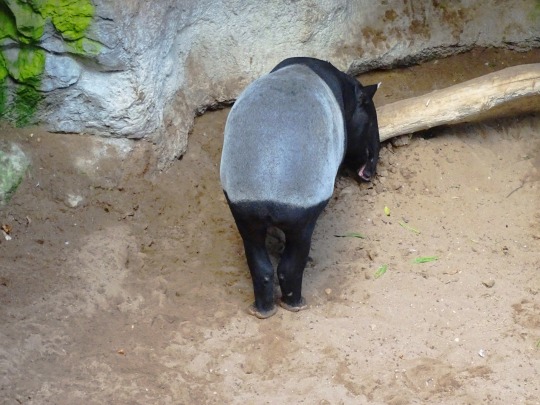


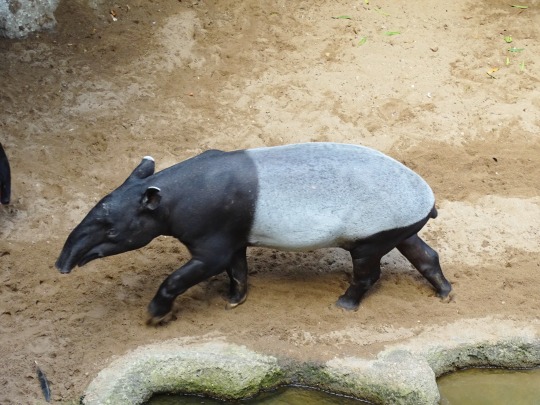




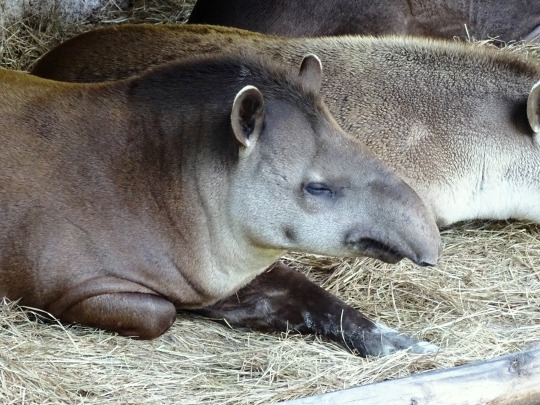

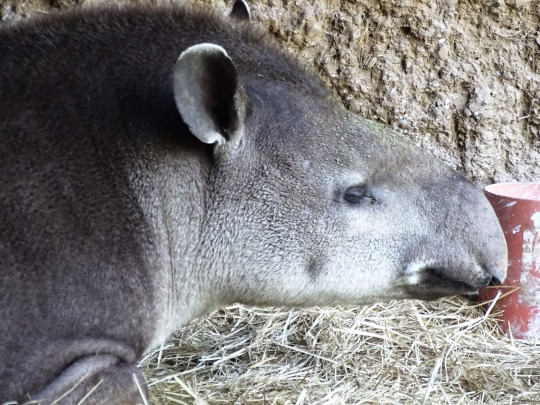
World Tapir Day
Learn about the highly endangered creature known as the tapir, and educate others, volunteer, or donate to help preserve these fascinating mammals.
Let’s dive into the fascinating world of tapirs with World Tapir Day! Celebrated every year on April 27, this day is all about shining a spotlight on these unique creatures. Since its start in 2008, the event has aimed to increase awareness and support for tapir conservation.
Why celebrate tapirs, you ask? Well, many people don’t even know these animals exist. They’re often mistaken for other species, even in places where they naturally live.
Tapirs are crucial for their ecosystems, helping forests grow by spreading seeds. But they’re in danger due to habitat loss and other human activities. World Tapir Day is here to change that by educating people and rallying support for these shy giants.
How can we make a difference? Simple acts like learning more about tapirs, sharing information, and supporting conservation efforts can have a big impact.
You can also donate to organizations working to protect tapir habitats or take part in local events and activities. Together, we can help ensure tapirs thrive for generations to come.
History of World Tapir Day
World Tapir Day is a unique celebration dedicated to raising awareness about tapirs, those curious creatures that have roamed the Earth for millions of years.
This special day was officially launched in 2008 and is celebrated annually on April 27. It wasn’t until 2011, however, that the celebration really took off, thanks to the passionate efforts of tapir enthusiasts and conservationists who recognized the need to highlight these lesser-known animals.
Their goal was to educate the public about the critical role tapirs play in their ecosystems and the threats they face, such as habitat loss and hunting.
The founding of World Tapir Day marked the beginning of a concerted effort to put tapirs on the global conservation agenda.
By drawing attention to their plight, the day aims to inspire actions that help ensure their survival. Zoos, wildlife organizations, and conservation groups around the world participate by hosting events, educational programs, and social media campaigns to spread the word.
Activities range from visiting tapirs at local zoos to engaging in conservation fundraising efforts.
The significance of World Tapir Day has grown over the years, reflecting the increasing urgency of protecting these animals and their habitats. All four recognized species of tapirs are currently listed as vulnerable or endangered.
The day serves as a reminder of the beauty and diversity of wildlife and the importance of conservation efforts to protect our planet’s biodiversity for future generations.
How to Celebrate World Tapir Day
Celebrating World Tapir Day can be both fun and meaningful with a sprinkle of creativity. Here are some playful suggestions that don’t just stick to the script:
Dress Up as a Tapir: Grab some grey or black clothes, fashion a snout, and maybe even some spots and stripes. Walk around your neighborhood or park, sparking curiosity and conversations about tapirs.
Tapir-Themed Art Day: Gather your friends or family and create tapir-inspired artwork. Paint, draw, or even create digital art—let your imagination run wild. Share your masterpieces online to spread the love for these unique creatures.
Movie Night with a Twist: Host a movie night featuring documentaries or films about tapirs and their habitats. It’s a cozy way to learn about these animals and the challenges they face.
“Adopt” a Tapir: Many conservation organizations offer symbolic adoption programs. Adopting a tapir can be a great way to support its protection and learn more about the specific animal.
Tapir Trivia Night: Organize a trivia night with facts about tapirs. It’s a fun way to educate and challenge your friends and family about tapir knowledge.
Visit a Zoo Virtually or In-Person: If you can’t make it to a zoo, many offer virtual tours where you can see tapirs. For those who can visit in person, it’s a great opportunity to learn firsthand about these animals.
Tapir Treats Bake-off: Get creative in the kitchen by baking cookies or cakes shaped like tapirs. Share your creations with friends or on social media to spread awareness in the sweetest way possible.
These ideas make sure the spotlight is on these fascinating creatures and the efforts to conserve them.
Source
#Brazilian tapir#World Tapir Day#WorldTapirDay#27 Apil#animal#daytrip#Zoo Zürich#Zurich#Switzerland#Bronx Zoo#my favorite zoo#New York City#USA#travel#original photography#South American tapir#Malayan tapir#Asian Tapir#close up#head#detail#Schweiz#spring 2018#summer 2018#flora#fauna#nature#vacation#tourist attraction#landmark
1 note
·
View note
Text
orville peck: appropriation and intellectual property
Orville Peck is a white South African man who has built his entire career off of colonial North American western aesthetics that are directly influenced by Métis and First Nations cultures and aesthetics. This aesthetic is incredibly loaded and has a history that he seemingly has no understanding of other than the fact that often cowboys were queer. In fact, Peck has gone so far as to rip off Métis and Saulteaux artist Dayna Danger.

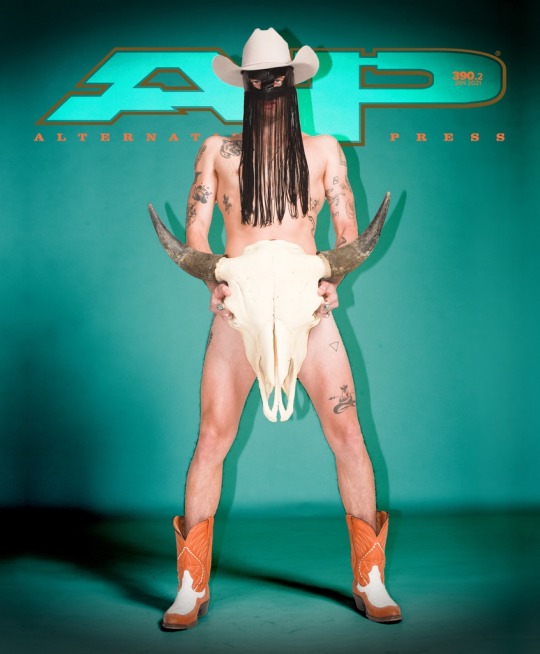
Fig. 1: Danger, Dayna. Big’Uns: Adrienne, 2017. Courtesy of the artist’s website.
Fig. 2: Orville Peck for Alternative Press Magazine, January 2021
The first image is from a series of similar photographs created by Dayna Danger, well known contemporary artist from Winnipeg, Manitoba. The second image is Orville Peck's cover for Alternative Press magazine's January 2021 issue. In addition to the responsibility of the photographers and stylists to be researching artwork and influences and giving proper credit, it is also up to all parties to understand the colonial implications of the material culture represented in Peck's magazine cover.
Given that Peck is a white South African man I highly doubt he has an actual understanding of how North America was colonized, how animals like bison were hunted into near extinction by white settlers seeking to starve the First Nations and Métis people into extinction as a tool in their ongoing genocide. Many populations of native fauna are still recovering from this practice. In addition to slaughtering millions of animals, white settlers posed proudly with their trophies, mountains of skulls representing the loss of our animals and their triumph over nature and our people.

Fig. 3: Men standing with pile of buffalo skulls, Michigan Carbon Works, Rougeville MI, 1892. Photo from Burton Historical Collection, Detroit Public Library
Rather than providing an artistic compliment on the history of North American colonialism and cowboy culture, Orville Peck culture hopped from one settler-colonial state to another, to profit from and flatten the aesthetic into something simply rooted in queer culture rather than Black, Mexican, Métis, and First Nations communities and histories.
Works Cited:
Alternative Press. Orville Peck cover, January 2021.
Danger, Dayna. Big'Uns: Adrienne, 2017. https://www.daynadanger.com/photography
Tascheru Mamers, Danielle. Men standing with pile of buffalo skulls, Michigan Carbon Works, Rougeville MI, 1892. Photo from Burton Historical Collection, Detroit Public Library. December 2020.
30 notes
·
View notes
Text

✦ THIRD-WORLD PUNKS ✦ INTRODUCTION
“Who are we? We are the global South, that large set of creations and creatures that has been sacrificed to the infinite voracity of capitalism, colonialism, patriarchy, and all their satellite-oppressions. We are present at every cardinal point because our geography is the geography of injustice and oppression. We are not everyone; we are those who do not resign themselves to sacrifice and therefore resist. We have dignity. We are all indigenous peoples because we are where we have always been, before we had owners, masters, or bosses, or because we are where we were taken against our will and where owners, masters, or bosses were imposed on us. They want to impose on us the fear of having a boss and the fear of not having a boss, so that we may not imagine ourselves without fear. We resist. We are widely diverse human beings united by the idea that the understanding of the world is much larger than the Western understanding of the world. We believe that the transformation of the world may also occur in ways not foreseen by the global North. We are animals and plants, biodiversity and water, earth and Pachamama, ancestors and future generations—whose suffering appears less in the news than the suffering of humans but is closely linked to theirs, even though they may be unaware of it.” — Boaventura de Sousa Santos, Epistemologies of the South: Justice Against Epistemicide.
We are THIRD-WORLD PUNKS, a blog devoted to cultivating a dark-academia aesthetic inspired by Latin America and the UK Punk Scene. I'm your host, PHILOSOPHIKA, a 33-year-old British and Colombian philosopher specialising in aesthetics (the branch of philosophy that studies concepts such as beauty and ugliness and investigates the nature of art and the senses) and anti-totalitarian ethics. Keep reading to learn more about the aesthetic's main goals, sources of inspiration, and suggested hashtags.
✦ OUR MISSION
To create a Latin American take on the 'dark academia' aesthetic from the perspective of the region's actual inhabitants. The T.W.P. aesthetic actively avoids depicting the region as a holiday destination (fruity drinks, trendy hotels, sexy pool boys, designer sunglasses, etc.) or representing the culture through a tourist's eyes (for example, as exclusively consisting of festivals or big public events). This aesthetic should provide the viewer with an intimate portrait of what it's actually like to call this region home. Images of local food, daily customs, traditional clothing, distinctive architecture, weather patterns, etc., are encouraged.
To provide a modern fusion between Latin American (principally Colombian) and UK culture that does not reproduce the aesthetics of British colonialism. To this end, the T.W.P. aesthetic steers clear of antique botanical prints, colonial uniforms, overly beige colour palettes, floral chintz wallpapers or decorative accents, leather trunks, and/or anything even faintly reminiscent of a plantation. Emphasis is placed instead on UK Punk fashion and culture (think Camden Market and Vivienne Westwood), extravagant and eclectic UK (& European) architecture and interior design, and Oxbridge academia vibes.
To challenge what traditional academia looks and feels like, as well as its core tenets (eurocentrism, US-centrism, elitism, abelism, etc.). The T.W.P aesthetic celebrates and encourages out-of-the-box thinking, ethnic and racial diversity, neurodivergent and LGBTQIA+ higher education experiences, as well as discussions of postcolonial, queer, and feminist theory, among others (think TWAIL: Third-World Approaches to International Law). Quotations, reading lists, book recommendations or reviews, and catchphrases along these lines are welcome.
✦ SOURCES OF INSPIRATION
— art deco/decopunk — art nouveau — solarpunk— steampunk — gutterpunk — latin american geography, flora & fauna — latin american culture — spanish colonial architecture — pre-columbian latin america — 70's & 80's uk punk scene — elements of cyberpunk — alternative fashion — maximalism — haute boheme aesthetic
✦ RELEVANT HASHTAGS
Do you want to tag something with this aesthetic on your blog? Check out the suggestions below:
#TWP — #TWPs — #TWP Aesthetic — #TWPs Aesthetic | #Third-World Punks — #Third World Punks — #Third-World Punks Aesthetic —
#Third-World Punks#Third World Punks#tropical dark academia#dark academia aesthetic#dark academia#aesthetic#moodboard#global south#south america#latin america#latin america aesthetic#South America Aesthetic#Tropical Aesthetic#Global South Aesthetic#Rainforest#Jungle Aesthetic#academia#chaotic academia#tropical academia#Punk#rebelcore#Alternative aesthetic#alternative#alt style#alternative fashion#TWP#TWP Aesthetic#TWPs#Third-World Punks Aesthetic#TWPs Aesthetic
14 notes
·
View notes
Text

Another year later (two years after the initial prompt, oops), I finally finished the last of the Magizoology-specific one shots I had been planning, prompted by @dumpsterhipster and @a-more-delicious-happiness. Here is Part 2 of "In Hot Water," which picks up immediately where Part 1 left off.
As a bonus, here's two photos I took in the Green Swamp, the setting I based this whole ficlet on. Enjoy!


Left: sundew; Right: longleaf pine savanna
* * * *
In Hot Water - Part 2 (Lily)
We realized the sun was going down when the tree trunks adopted a gold halo, their bark darkening against the light. Taking that as a sign to go, I stood up to find the knees of my jeans wet from the damp ground—and that I had been kneeling on a patch of sundew. Tanner’s ribbing at my “involuntary plant-slaughter” (“They’re not dead!” I protested. “Just a little…flatter.”) only increased when I clumsily step-hopped back to the trail to avoid trampling several tiny red-mouthed Venus flytraps. I wasn’t completely successful.
“You know,” he teased, “it’s generally a good idea not to step on the rare plants.”
I tripped over the air while I tried to hop away from another flytrap. “Maybe if the rare plants weren’t everywhere, I wouldn’t step on them.”
“Aaand this is why we stay on the trail.”
“You took me off the trail! Oh, shut up,” I added when he laughed.
A red-headed woodpecker flitted overhead, followed by a second one soon after, their black and white wings a sharp contrast against the green and gold savanna. They flap-bounded from slender trunk to slender trunk, pausing for no more than a few seconds at a time before continuing on. Foraging for insects? Or on their way home for the evening?
Distracted, I had to catch myself before I could stumble off the narrow path again. Long grass brushed my fingertips. There were so many little things to look at my brain felt split multiple ways. For once, it wasn’t a bad feeling. I could linger in this quiet plant world for ages—let the softly buzzing spring air wash over me with all its earthiness and gentle humidity.
Tanner halted, an unintelligible burble preceding any coherent words. He pointed towards a thicker patch of brush thirty or so meters in front of us.
I squinted, expecting another weird salamander or rare plant. “What?”
“I thought I saw a bobcat.”
I immediately refocused. “You’re sure?”
“Tan, furry, big. Could’ve been a coyote. Didn’t move like one though.”
We shut our mouths by unspoken agreement, not moving a muscle as we watched the brush patch. I had never seen a bobcat before, or a coyote, both being North American natives, and a little thrill ran through me at the thought. If there was any way to elevate an already awesome trip even more…
The brush rustled. Tanner had been right—tan fur moved amongst the tangled grass. Slunk, more accurately. The creature’s smooth, near-soundless steps were distinctly cat-like. When he had said “big,” though, I had assumed he had meant big as in relative to a squirrel. Not genuinely big. The cat must have stood a full meter tall at the shoulders, if not taller. Weren’t bobcats this far south supposed to be small? Because of the heat or something?
Those were strong shoulders too, rippling with muscle. As the creature prowled out of the grass, its long tail swished along the ground.
“That’s not…” Tanner breathed. Not a bobcat. The lack of that particular feature was literally in the name. But there were no other big cats in the region, magical or otherwise. True to Magizoologist form, I had looked up the local large fauna before my flight. The only remaining possibility lived hours to the west, in the mountains. There was no way it could—
Six tawny legs padded out of the grass. Tanner averted his gaze with a restrained curse. A right genius, I stared dead into the wampus cat’s golden eyes.
The mountain cracked around me. Cracked and then crumbled. Colossal yellow beasts with iron teeth tore through the trees, toppling great pines as easily as twigs. I ran and the earth gave chase. The mud came alive, clinging to my paws, rushing up along my belly, weighing on my pelt. Down the mountain we swept, heavy mud and heavy fur. A deer lay swollen and stiff on the creek bank, the water’s sheen sickeningly acrid on the tongue.
Miles and days, rain and thirst, heat and hunger. Blinding lights roared in the dark, screaming their rage through an oily scar in the earth. They blasted their heat over my pelt, a warning left in mangled corpses tasting of bitter smoke. In the home that no longer was, thunder shook the mountain’s heart. When I looked back, there was no mountain at all. Only a gaping stone wound baring blunt teeth to a hazy sky.
Images continued to flash, a cacophony of senses—noises, colors, scents, tastes, aches. Pain, sharp as a coyote’s maw snapped around my leg. Elation, rich as blood filled my mouth. Terror, cold as bark splintered in a burst meant for my heart. Satisfaction, soft as I stretched between the sunshine on my belly and the grass on my back. With each powerful step, each numbered breath, I was fiercely, agonizingly alive. How fragile it all was, a flame to be snuffed out with the slightest exhalation, a heart that could beat so hard it stopped.
How fragile it all was before the two awkward creatures beneath the pines, their pelts smooth and colorful like bird feathers. Loud, clumsy creatures, too pathetic to hunt for themselves. Real birds fled in their crashing wake. The rodents stayed underground, knowing better than to poke their heads up to get trampled. Dangerous, untrustworthy creatures, smelling of acrid oil and bitter smoke. The prey would not return until long after they were gone.
Golden eyes flared in shadows cast by dying light. Leave, clumsy pests. Shoo.
The connection broke like an elastic band stretched too far—severed with a horrendous snap. I gasped with the shock of remembering I had lungs to breathe. My feet scrambled over the ground, not fully underneath me. Tanner’s arms were hooked under my armpits from behind, his hands twisted to grip my shoulders as I found my footing. A tawny blur slunk off into the bushes.
“I’m okay!” I exclaimed. “I’m okay!”
Tanner kept a hand on my shoulder even after I stood upright. “What’s your name?”
“Lilianna Flores. But it didn’t—”
“Where are we right now? What’s today’s date?”
I shook him off, my head buzzing. “Did you see that?”
“Did I see what the hypnotism cat had to say?” he said, bemused. “No, I was a little distracted by all this.” He waved his hands at me.
“Not hypnotism. Legilimency. Really really strong Legilimency. I saw us and…and…” I trailed off, at a loss. I could taste the blood in my mouth, still warm. Had that been before or after the end of the world?
“Did it tell you why it’s three hundred miles outside of its home range?”
A gaping stone wound, the heart of a mountain carved out. “Er, I don’t think it has a home range anymore.”
“That’s…not good.” Tanner rubbed his brow. “I’ll send a report to the Wildlife Commission when we get in. It shouldn’t be here.”
“Yeah.” Leave, clumsy pests. “Yeah, that’s probably for the best.”
“Are you good to Apparate? I’d rather not get caught in the dark with a wampus cat on the loose.”
“Right.” I offered him my arm. With a crack, we squeezed through time and space to reappear on a sandy roadside, the slender pines at our backs. A flock of sparrows flushed out over a small pond, whistling their alarm calls. I stared at the empty road, weirdly out of place after so long in the savanna. Back to the real world, I supposed.
Once we were safely buckled in Tanner’s truck, he started laughing, bracing himself against the steering wheel as full guffaws rose from his belly. “Why is it that every time I go into the field with you, something weird happens?”
I grinned. “I have a way with cats.”
“And dragons. And who knows what else.”
“Remind me to show you the Creature Reserve if you’re ever across the pond.”
“I’ll be sure to take you up on that.”
He turned the key in the ignition, then flicked the headlights on as the engine shuddered to life. Blinding lights roaring in the dark.
“Does it ever feel like a wasted effort?” I asked abruptly. “What we do? Because sometimes I feel like we’re just documenting the apocalypse.”
He snorted. “Every day. It’s exhausting. Though I don’t know about wasted. It would be a whole lot worse if we didn’t try, right?”
“I guess that’s right.”
“Besides, who else gets to see a boiling salamander and a six-legged cat in one day? Don’t tell me you’re getting tired of it already?”
“No,” I chuckled. “No, you’re right. Forget I said anything.”
The truck pulled out onto the road as golden hour began to fade. Amidst the aftertaste of oil and smoke, sunshine lingered in the grass.
7 notes
·
View notes